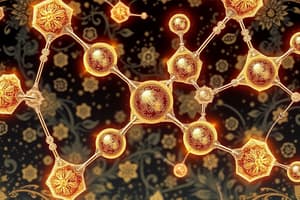Podcast
Questions and Answers
What are atoms composed of?
What are atoms composed of?
A dense, positively charged nucleus surrounded by negatively charged electrons.
What are isotopes?
What are isotopes?
Atoms with the same atomic number but different mass numbers.
What is the atomic mass of carbon?
What is the atomic mass of carbon?
- 14.007 amu
- 30.974 amu
- 12.011 amu (correct)
- 1.008 amu
Electrons in an atom have a significant mass compared to protons.
Electrons in an atom have a significant mass compared to protons.
Which principle states that the lowest-energy orbitals fill up first?
Which principle states that the lowest-energy orbitals fill up first?
How many valence electrons does carbon have?
How many valence electrons does carbon have?
The two lobes of each orbital are separated by a region of zero electron density called a ______.
The two lobes of each orbital are separated by a region of zero electron density called a ______.
Match the following rules of electron configuration:
Match the following rules of electron configuration:
Flashcards are hidden until you start studying
Study Notes
Structure and Bonding
- Understand concepts of general chemistry including electronic structure, types of bonding, electronegativity, and formal charges.
- Predict covalent and ionic bonding patterns for elements C, H, O, N, and halogens.
- Evaluate the resonance forms of stabilized structures in organic chemistry.
- Interpret various structural formulas: condensed structural formulas and line-angle formulas.
- Predict organic molecules' hybridization and geometry based on bonding.
- Analyze isomers for structural differences.
Principles of Atomic Structure
- Atoms consist of a dense, positively charged nucleus centered around negatively charged electrons.
- The nucleus contains protons (positive charge) and neutrons (neutral charge).
- The nucleus measures approximately 10^-14 to 10^-15 m in diameter, holding nearly all of the atom's mass.
- Electrons have negligible mass, circulating around the nucleus about 10^-10 m away, giving a typical atom a diameter of about 200 picometers (pm).
Isotopes
- Isotopes are atoms with the same atomic number but varying mass numbers.
- Example: Carbon isotopes include Carbon-12 and Carbon-14, differing in neutron count.
Atomic Mass
- Atomic mass reflects the weighted average of an element’s naturally occurring isotopes, measured in atomic mass units (amu).
- Examples: Hydrogen = 1.008 amu, Carbon = 12.011 amu, Phosphorus = 30.974 amu.
Orbitals
- An orbital indicates the volume around a nucleus where an electron is likely to be found, covering 90%-95% of its time.
- Orbitals have lobes separated by nodes, regions with zero electron density.
- Electron shells (quantum number n) organize orbitals with increasing size and energy.
Electron Configuration
- The ground-state electron configuration is the lowest-energy arrangement of electrons in orbitals.
- Follows the Aufbau principle: lowest-energy orbitals fill first in this order: 1s, 2s, 2p, 3s, 3p, 4s, 3d, etc.
- Pauli exclusion principle states that two electrons in the same orbital must have opposite spins.
- Hund's rule dictates that, when multiple equal-energy orbitals are available, one electron occupies each before pairs are formed.
Valence Electrons
- Valence electrons are located in the outermost shell of an atom.
- Carbon has four valence electrons, located in Group 4A of the periodic table.
Studying That Suits You
Use AI to generate personalized quizzes and flashcards to suit your learning preferences.




